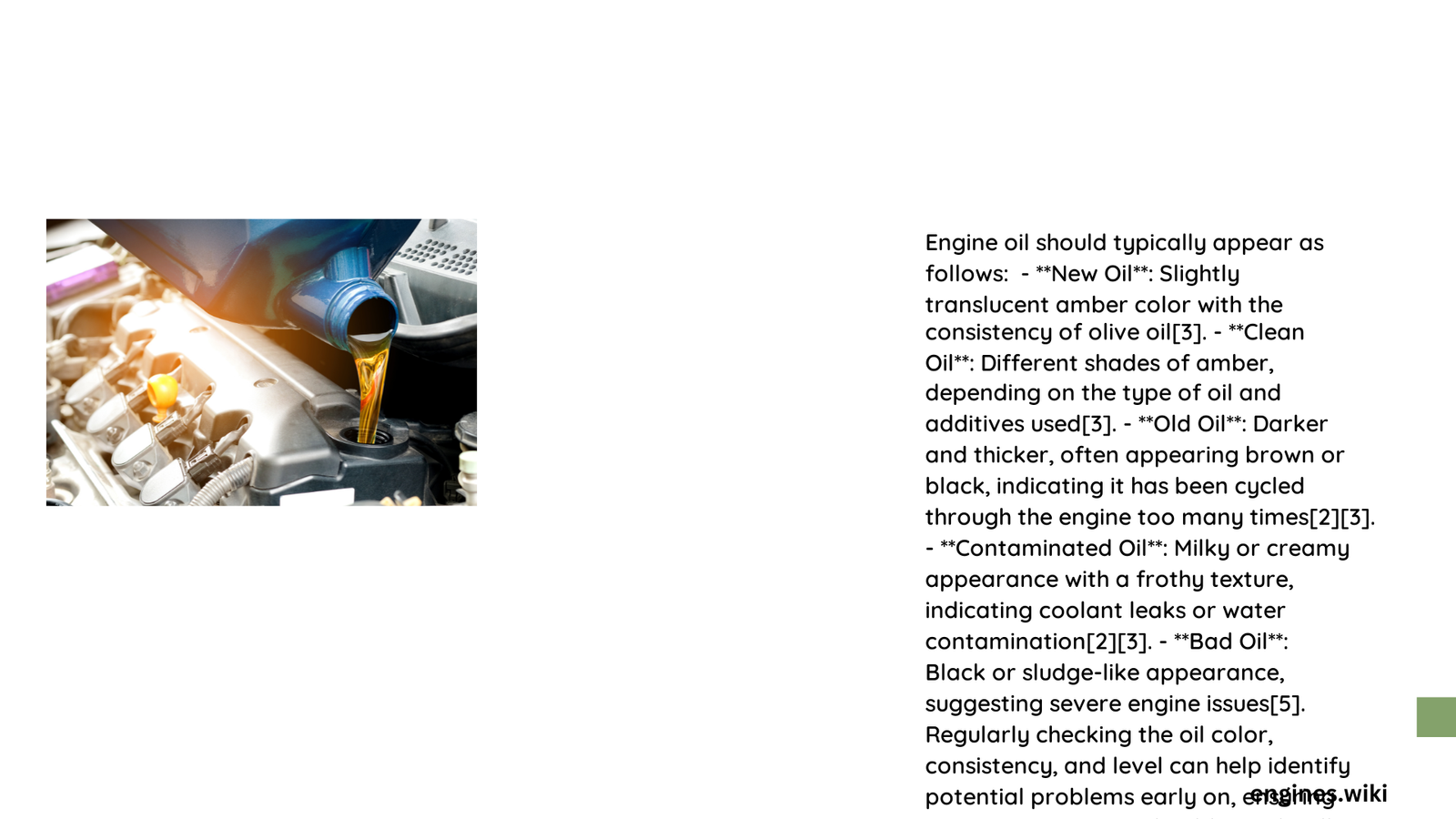Engine oil is the lifeblood of your vehicle’s engine, and its appearance can reveal critical insights into the health and performance of your automotive powerplant. Understanding how engine oil should look involves examining its color, clarity, and consistency, which serve as key indicators of lubrication quality, potential contamination, and overall engine condition.\n\n## What Color Indicates Healthy Engine Oil?\n\nHealthy engine oil typically presents a golden to amber color, resembling liquid honey. This pristine appearance signifies fresh, clean oil that is ready to protect and lubricate your engine’s intricate components. As oil ages and accumulates microscopic particles, its color will naturally darken, transitioning to a deeper brown or light black shade.\n\n### Visual Characteristics of Quality Engine Oil\n\n| Characteristic | Healthy Condition | Warning Signs |\n|—————|——————-|—————|\n| Color | Golden/Amber | Dark Brown/Black |\n| Clarity | Translucent | Cloudy/Milky |\n| Consistency | Smooth Flow | Thick/Sludgy |\n\n## What Contaminants Change Oil Appearance?\n\nSeveral factors can alter engine oil’s appearance:\n\n- Metal Particles: Tiny metal shavings from engine wear can darken oil\n- Dirt and Debris: External contaminants reduce oil clarity\n- Coolant Leakage: Creates a milky, frothy appearance\n- Excessive Heat: Accelerates oil breakdown and color changes\n\n## How to Perform a Visual Oil Inspection?\n\nConducting a thorough oil inspection requires careful observation:\n\n1. Use Natural Light: Check oil color in daylight for accurate assessment\n2. Clean Dipstick Method:
– Wipe dipstick on white cloth\n – Examine color and consistency\n – Look for unusual textures or particulates\n3. Frequency: Inspect oil every 1,000-5,000 miles\n\n## When Should You Change Your Engine Oil?\n\nConsider an oil change if you observe:\n- Extremely dark or black oil\n- Milky or frothy appearance\n- Visible metal particles\n- Significant thickness or sludge formation\n\n## Professional Oil Analysis Options\n\nFor comprehensive insights, consider professional oil analysis services:\n\n- Basic Test: $10-$30\n- Comprehensive Analysis: $50-$100\n- Advanced Diagnostic: $100-$250\n\n### Key Diagnostic Parameters\n\n- Viscosity measurement\n- Contaminant identification\n- Wear metal analysis\n- Additive package evaluation\n\n## Potential Risks of Ignoring Oil Condition\n\nNeglecting oil appearance can lead to:\n- Accelerated engine wear\n- Reduced fuel efficiency\n- Potential catastrophic engine failure\n- Increased maintenance costs\n\n## Expert Recommendations\n\n- Regular Inspection: Check oil monthly\n- Follow Manufacturer Guidelines: Adhere to recommended oil change intervals\n- Use High-Quality Oil: Invest in premium lubricants\n- Monitor Driving Conditions: Adjust maintenance based on usage\n\n## Conclusion\n\nUnderstanding how engine oil should look is crucial for maintaining your vehicle’s performance and longevity. By paying attention to color, clarity, and consistency, you can proactively manage your engine’s health and prevent costly repairs.\n\n### Reference:\n- Automotive Maintenance Guide\n- Engine Oil Analysis Techniques\n- Professional Lubrication Standards

